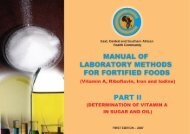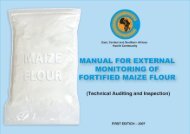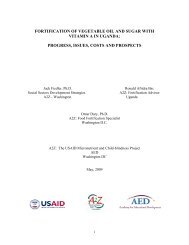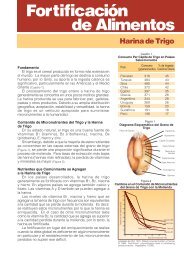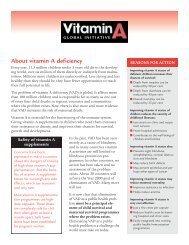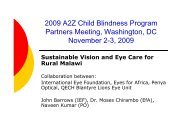manual of methods for determining micronutrients in fortified foods
manual of methods for determining micronutrients in fortified foods
manual of methods for determining micronutrients in fortified foods
Create successful ePaper yourself
Turn your PDF publications into a flip-book with our unique Google optimized e-Paper software.
6. Ammonium hydroxide-0.1M: In a 100-mL volumetric flask with 50 mL distilled water, add 1.4<br />
mL concentrated ammonia and br<strong>in</strong>g to volume with distilled water.<br />
7. Sodium hydroxide-0.1N: Weigh 4 g sodium hydroxide. Dissolve <strong>in</strong> a 500-mL beaker with 300<br />
mL distilled water. Cool the solution down <strong>in</strong> a cold water bath. Transfer the solution to a 1-L<br />
volumetric flask. Wash the beaker with distilled water and transfer the wash<strong>in</strong>gs to the flask. Br<strong>in</strong>g<br />
to volume with distilled water. Store the solution at room temperature <strong>in</strong> a polyethylene conta<strong>in</strong>er.<br />
Solution is stable <strong>in</strong>def<strong>in</strong>itely. Do not use <strong>for</strong> titrations.<br />
8. Sodium hydroxide-0.01N: In a 1-L volumetric flask conta<strong>in</strong><strong>in</strong>g distilled water, add 100 mL<br />
sodium hydroxide solution-0.1N and br<strong>in</strong>g to volume with water. Store at room temperature <strong>in</strong> a<br />
polyethylene conta<strong>in</strong>er. The solution is stable <strong>in</strong>def<strong>in</strong>itely.<br />
9. Sterile isotonic sal<strong>in</strong>e solution-0.9% p/v: Weigh 9 g sodium chloride <strong>in</strong> a 250-mL, dissolve with<br />
100 mL distilled water. Transfer the solution to a 1-L volumetric flask. Wash the beaker and transfer<br />
the wash<strong>in</strong>gs to the flask. Br<strong>in</strong>g to volume with distilled water. Transfer the solution to a bottle and<br />
sterilize <strong>in</strong> an autoclave at 121-124°C <strong>for</strong> 30 m<strong>in</strong>utes.<br />
B. Standard solutions <strong>of</strong> folic acid<br />
1. Stock solution-100mg/L: Dry around 1 g standard folic acid (USP) <strong>in</strong> a porcela<strong>in</strong> crucible <strong>in</strong> an<br />
oven at 100-110°C to constant weight. As an alternative, it can be dried <strong>in</strong> a moisture analyzer (see<br />
picture below). Moisture content is compared to the maximum moisture content <strong>in</strong> the certificate<br />
and correction <strong>for</strong> purity and moisture is calculated when calculat<strong>in</strong>g the concentration.<br />
2. Weigh 50 mg standard and dissolve with phosphates buffer-0.1M pH=7 and br<strong>in</strong>g to volume to 500<br />
mL. Store the solution <strong>in</strong> the refrigerator <strong>in</strong> a dark conta<strong>in</strong>er with a 2-mm toluene layer. Solution is<br />
stable <strong>for</strong> two months.<br />
Concentration:<br />
• Transfer 10 mL stock standard solution-100 mg/L to a 100-mL volumetric flask and br<strong>in</strong>g to volume<br />
with phosphates buffer-0.1M, pH=7.<br />
• Read the absorbance <strong>of</strong> the solution at 282nm and 346 nm <strong>in</strong> a UV-spectrophotometer with 1-cm<br />
light path cuvettes. Zero the <strong>in</strong>strument with phosphates buffer 0.1M, pH=7. Get three read<strong>in</strong>g at<br />
each wavelength.<br />
• Calculate the average <strong>of</strong> the absorbances and multiply the results by 160 <strong>for</strong> the absorbances at 282<br />
nm and by 613.33 <strong>for</strong> the read<strong>in</strong>gs at 346 nm.<br />
- 53 -






